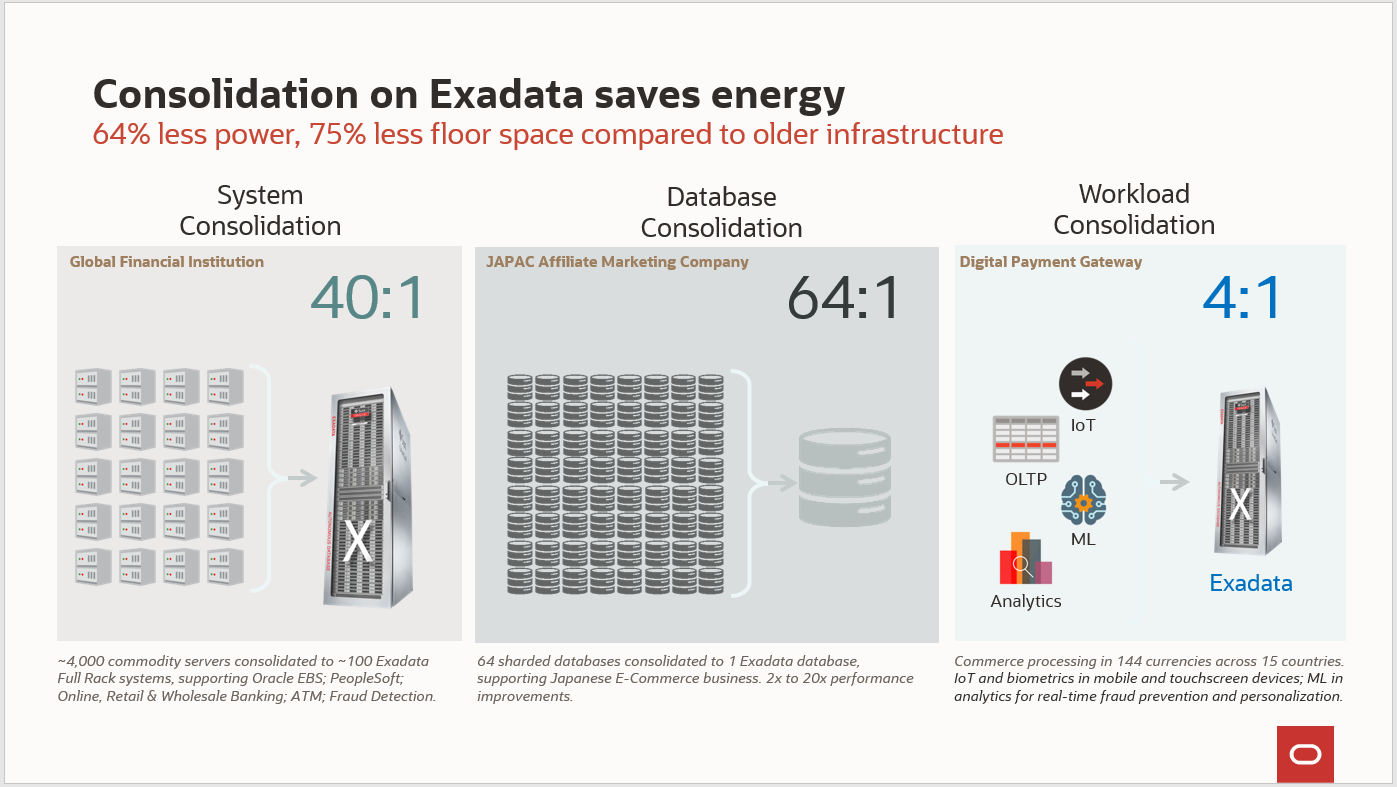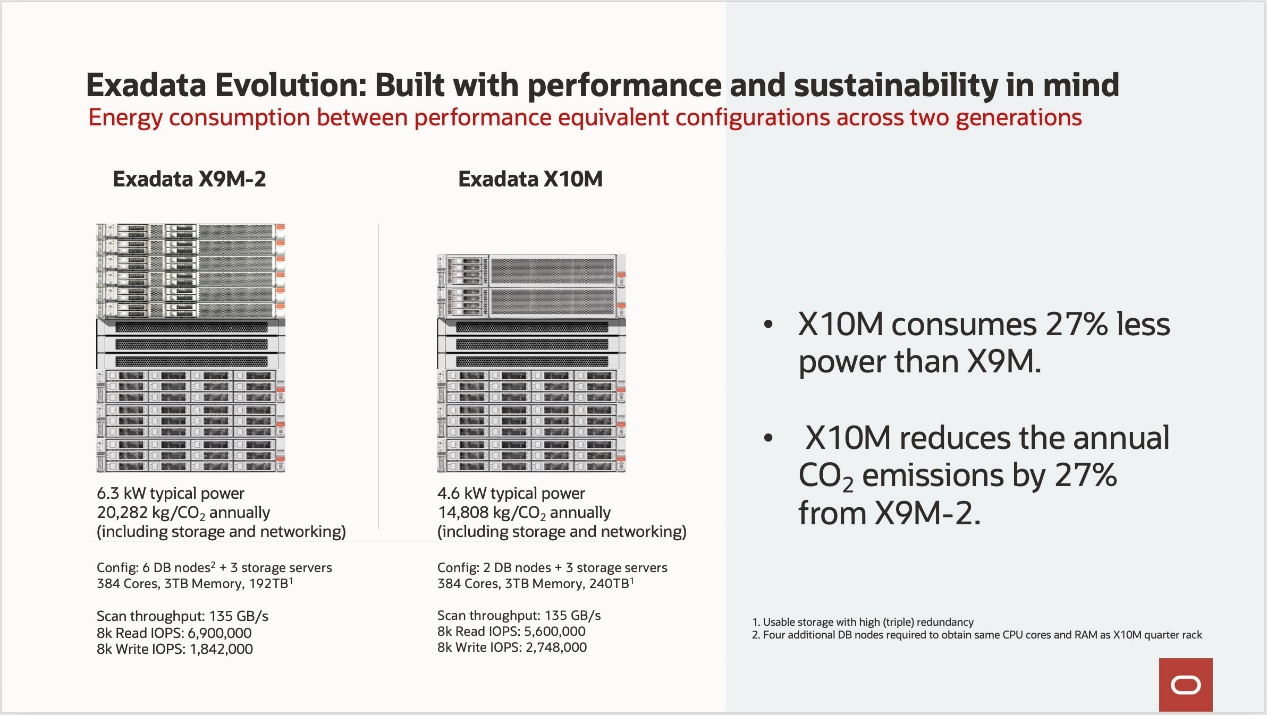Oracle Exadata Database Machine (Exadata) is an engineered system that integrates hardware and software with advanced database-aware algorithms to run Oracle Databases optimally for all workloads. Since its inception, Exadata has increased the hardware capacity in all facets of its architecture, scaling to thousands of cores, terabytes of memory, and petabytes of storage, enabling customers to run large-scale Databases or consolidate workloads into a single Exadata system. Exadata X10M extends these resources, supporting 192 CPU cores, up to 3TB of memory per database server, and up to 4.2 PB raw capacity per rack. You can read more about Exadata X10M here.
It is good that Exadata is packed with resources to run databases efficiently, but what about the environmental impact of running such a powerful machine? How does Exadata help increase data center energy efficiency?
In this post, we’ll explore some Exadata features that help reduce energy consumption and environmental impact while maintaining high performance for all workloads.
Server virtualization and workload consolidation
One of the best ways to minimize energy consumption in a data center is to reduce the number of servers and storage systems. Exadata is designed to run OLTP and DW/Analytics workloads at the highest performance with optimizations in both Oracle Database and Exadata System Software, including Exadata RDMA Memory, Smart Scan (Storage Offload), Storage Indexes, Columnar Cache on Storage Servers and many more. Combining these software optimizations with its robust hardware capabilities, Exadata is the ideal platform to consolidate Oracle Databases that run all workloads, leveraging its many resource management features such as IO Resource Manager and Virtualization.
Exadata uniquely consolidates the infrastructure, databases, and multiple workloads into one system and database engine. The graphic below depicts a few real-world examples of Customers using Exadata infrastructure to consolidate systems, databases, and workloads. With such significant consolidation, Exadata helped reduce the number of servers and storage systems, saving energy consumption. The power savings, and therefore the reduction of CO2 emissions, were significant.

We invite you to read the Exadata MAA white paper for more details on consolidating your Oracle Database environment to Exadata. In addition to consolidation, Exadata is efficient in virtualizing its servers to isolate different workloads. Exadata X10M, with its significant resources, can virtualize a physical server to many virtual servers, helping reduce the number of physical servers and their environmental impact.
In short, Exadata delivers faster performance and higher capacity than other platforms. It also enables customers to achieve higher levels of database consolidation, replacing more servers and storage systems to increase your data center’s energy efficiency.
CPU Frequency Management
Exadata X10M’s AMD 4th Generation EPYC processors operate at a base frequency of 2.6GHz and up to 3.7GHz, adjusting clock speed in real time in response to database workload changes. This can help conserve energy and reduce heat generation when the CPU is not under heavy load. Exadata X10M can complete tasks faster with optimal power consumption to meet performance and business needs.
In addition, Oracle Autonomous Databases running on Exadata Public Cloud and Exadata Cloud@Customer use auto-scaling features. This feature automatically adds or reduces the number of cores needed to handle a given workload, resulting in a more energy-efficient infrastructure and cost savings for customers. See details here. The Exadata infrastructure in both Oracle public cloud and Cloud@Customer is refreshed periodically, and it is Oracle’s responsibility to recycle, taking away that burden from the Customers.
Dynamic Cooling
Exadata servers automatically adjust the system’s cooling based on the database workload. In addition to Oracle Database, Exadata’s co-engineering capabilities extend to vital hardware components such as processors and NVMe flash devices. These key components are sensitive to higher temperatures and operate at lower performance when the temperature is too high. The Exadata servers dynamically modulate the fan speed based on the workload to ensure enough cooling for maximum system performance. This process reduces the cooling required during lighter workloads, providing energy efficiency, optimizing performance, and lowering cost.
Capacity-on-Demand (CoD)
Customers sometimes do not need to run the Exadata database server at full throttle (utilizing all 192 cores in the Exadata X10M server). Exadata’s Capacity-on-Demand (CoD) feature is a mechanism to control the number of active CPU cores by deactivating cores at initial deployment. Some cores are initially deactivated to control database licenses’ usage. Some customers start with fewer cores enabled and enable more processor cores as workloads increase or more databases are consolidated onto Exadata. An added benefit is that they can save energy consumption by deactivating some of the cores.
Environmental impact of Exadata X10M compared to Exadata X9M-2
Each new generation of Exadata pushes the boundaries of performance and overall energy efficiency. The latest generation Exadata X10M Database Server utilizes 3x more cores and 1.5x more memory than the previous generation Exadata X9M-2 and adds 22% more capacity than the previous generation Exadata X9M-2 Storage Server, enabling customers to run 3x higher OLTP transactions and 3.6x more analytic queries. This allows customers to do more with fewer systems, thereby reducing energy consumption. The graphic below shows the environmental impact of performance equivalent Exadata X10M compared to Exadata X9M-2, normalized for the number of CPU cores and memory.

The above graphic shows an Exadata X10M with 2 Database and 3 Storage servers and its performance equivalent, Exadata X9M-2 with 6 Database and 3 Storage servers. The energy consumed on Exadata X10M is 27% lower than on Exadata X9M-2. The scan throughput (outcome of analytics queries), which is directly related to the number of storage servers, is the same in both generations; however, the 8K Read IOPS, which is a function of both the number of database servers and storage servers is lower on Exadata X10M (since we are running 2 Database servers compared to 6 for Exadata X9M-2 configuration). The 8K Write IOPS is 49% higher on Exadata X10M than on Exadata X9M-2.
Conclusion
Exadata is a powerful database machine designed with performance and sustainability in mind. Compared to the previous generation, Exadata X10M reduces energy consumption, space requirements, and cooling needs, which helps customers lessen their environmental impact while running high-performance workloads. The Exadata Database machine also enables the reduction of the number of database servers and storage systems, thereby increasing data center efficiency. Exadata maximizes Oracle Database performance, empowering organizations to accelerate innovation and drive a more sustainable future through reduced energy consumption and improved data center efficiency.

